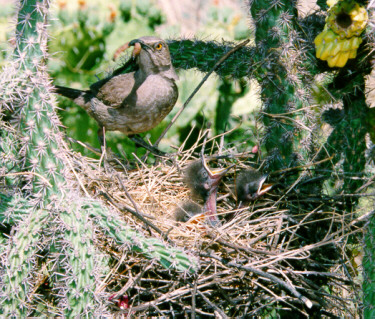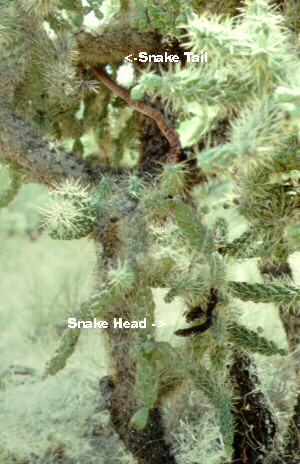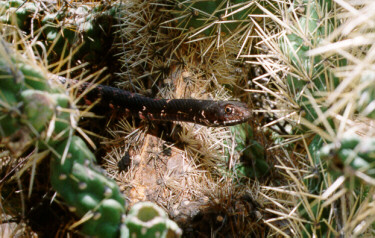Curve-bill Thrasher Feeding Young
Photo by Earle Robinson, April 1997
 The Curve-bill Thrasher is an early nester. In Sonoran desert habitat it is possible to find nests with eggs in February. One of the first things the prudent breeding bird surveyor does is look for any cholla cactus capable of supporting a stick nest. Very often the nest with eggs can be found before the bird is detected by ear.
The Curve-bill Thrasher is an early nester. In Sonoran desert habitat it is possible to find nests with eggs in February. One of the first things the prudent breeding bird surveyor does is look for any cholla cactus capable of supporting a stick nest. Very often the nest with eggs can be found before the bird is detected by ear.
In 1997 Tim and I were surveying in south-central Arizona. 1997 was also a drought year of historic proportions. The drought put enormous pressure on even the most desert-adapted birds like the Curve-bill Thrasher. Over the years we have found so many Curve-bill nests that when we approach the cactus, and see the nest, we automatically expect to see the eggs (if it is the appropriate time of year.) This unfortunate field habit gave us some surprises in 1997. First, we kept finding nests that had all the earmarks of a new nest where there should be eggs. The nests were lined with fresh materials and normally the only way to see a fresh-lined nest without eggs is just before the first egg is laid. Because we found so many fresh empty nests we knew something was happening to the eggs but we had no idea what. One morning I was looking for a Cactus Wren nest and a Curve-bill nest. Because the birds were there I knew the nests had to be there. I thought I had checked all the cholla and I was puzzled that I could not find the nest. About this time I noticed a Cactus Wren flying up to a Saguaro and I suspected that was where the nest for that bird was. I told Tim I couldn't find the Curve-bill nest and was going to check out the Cactus Wren to see if it had a nest in a saguaro cavity. Of course, Tim knows that the Curve-bill had to be there so he went to check for himself. I had just confirmed the Cactus Wren nest in the saguaro when Tim came running and hollering for me to bring a camera. I ran after Tim, passing all the cholla cactus I had checked, to a spot where there was cactus I hadn't seen. Seeing the Curve-bill nest I looked and saw the tail of a Coachwhip snake slowly making its exit from the nest. When Tim first saw the snake it was swallowing the last of the Curve-bill eggs. By the time I got there the head of the snake was nearly to the ground and only the tail was in the nest. (A medium-sized snake of the species would be about 175 cm, approximately the length of the snake we saw). Finally, we knew at least one reason why the eggs were not present in new nests. Apparently, the normal food source for coachwhips was gone and it was down to climbing every cholla cactus until it could find a nest with eggs. I wonder if they know which cactus to search, or if they just keep mindlessly climbing cholla cactus hoping to get lucky?
Cholla Cactus with Coachwhip Snake
Photo by Greg Clark, May 2, 1997
 Additional Curve-bill Topics and Photos
Additional Curve-bill Topics and Photos
The sound recording is approximately 481k and also contains some other birds in the background.
download mpeg3 recording (cbt.mp3)
Copyright Greg Clark, 1999
update 8/2012
Coachwhip Snake Head Closeup
